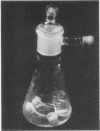Abstract
The effects of various treatments on the recently reported system in pea (Pisum sativum cv. Alaska), which results in (a) the incorporation of 14C2H4 into the tissue and (b) the conversion of 14C2H4 to 14CO2, was investigated using 2-day-old etiolated seedlings which exhibit a maximum response. Heat treatment (80 C, 1 min) completely inhibited both a and b, whereas homogenization completely inhibited b but only partially inhibited a. Detaching the cotyledons from the root-shoot axis immediately before exposing the detached cotyledons together with the root-shoot axis to 14C2H4 markedly reduced both a and b. Increasing the 14C2H4 concentration from 0.14 to over 100 μl/l progressively increased the rate of a and b with tissue incorporation being greater than 14C2H4 to 14CO2 conversion only below 0.3 μl/l 14C2H4. Reduction of the O2 concentration reduced both a and b, with over 99% inhibition occurring under anaerobic conditions. The addition of CO2 (5%) severely inhibited 14C2H4 to 14CO2 conversion without significantly affecting tissue incorporation. Exposure of etiolated seedlings to fluorescent light during 14C2H4 treatment was without effect. Similarly, indoleacetic acid, gibberellic acid, benzyladenine, abscisic acid, and dibutyryl cyclic adenosine monophosphate had no significant effect on either a or b.
The possibilities that the incorporation of 14C2H4 into pea tissues and its conversion to 14CO2 is linked to ethylene action, or that it represents a means of reducing the endogenous ethylene level, are discussed.
Several problems encountered with the use of polyethylene vials, rubber serum stoppers, Clorox, and microbial contamination are also described.
Full text
PDF





Images in this article
Selected References
These references are in PubMed. This may not be the complete list of references from this article.
- BURG S. P., BURG E. A. ETHYLENE ACTION AND THE RIPENING OF FRUITS. Science. 1965 May 28;148(3674):1190–1196. doi: 10.1126/science.148.3674.1190. [DOI] [PubMed] [Google Scholar]
- Beyer E. M. C(2)H(4): its purification for biological studies. Plant Physiol. 1975 May;55(5):845–848. doi: 10.1104/pp.55.5.845. [DOI] [PMC free article] [PubMed] [Google Scholar]
- Burg S. P., Burg E. A. Molecular requirements for the biological activity of ethylene. Plant Physiol. 1967 Jan;42(1):144–152. doi: 10.1104/pp.42.1.144. [DOI] [PMC free article] [PubMed] [Google Scholar]
- Carlton B. C., Peterson C. E., Tolbert N. E. Effects of ethylene & oxygen on production of a bitter compound by carrot roots. Plant Physiol. 1961 Sep;36(5):550–552. doi: 10.1104/pp.36.5.550. [DOI] [PMC free article] [PubMed] [Google Scholar]
- TOLBERT B. M., LEMMON R. M. Radiation decomposition of pure organic compounds. Radiat Res. 1955 Sep;3(1):52–67. [PubMed] [Google Scholar]
- Varner J. E., Balce L. V., Huang R. C. Senescence of Cotyledons of Germinating Peas. Influence of Axis Tissue. Plant Physiol. 1963 Jan;38(1):89–92. doi: 10.1104/pp.38.1.89. [DOI] [PMC free article] [PubMed] [Google Scholar]



